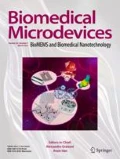Abstract
Extraction and purification of intact chromosomes are critical sample preparation steps for transchromosomic research and other applications. The commonly used sample preparation methods lead to too few chromosomes with chromosome deactivation and degradation. In this paper, a “mild” chromosome extraction process that combines a chemical and mechanical lysis approach is introduced for the preparation of intact chromosomes that can readily be used for downstream processing. Metaphase cells are treated by chemical lysis buffer and pushed through a microfluidic pinched flow device. Cells are ruptured, and chromosomes are released by a combination of shear stress and chemical reagents. Chromosomes are released intact from the cell membrane into the solution. Simulations and experiments are performed to optimize the microfluidic device geometry and operation parameters. Cell rupture and chromosome release are found to be improved by the shear stress in the pinched flow device. Simulation results indicate that the maximum shear stress appears in the channel constriction region, and the narrow channel maintains constant shear stress. It is concluded that the constriction design, narrow channel width, and operation flow rate have a significate influence on chromosome release. Utilizing an optimized device, near-complete cell lysis is achieved and 4 times as many chromosomes are released (8% in control experiments to 25% in optimized pinched flow devices). Sample treatment time can also be reduced utilizing this combined chemical-mechanical chromosome release method.









Similar content being viewed by others
References
D.D. Carlo, K.-H. Jeong, L.P. Lee, Reagentless mechanical cell lysis by nanoscale barbs in microchannels for sample preparation. Lab Chip 3(4), 287–291 (2003)
Fournier, R. E., and F. H. Ruddle. 1977. Microcell-mediated transfer of murine chromosomes into mouse, Chinese hamster, and human somatic cells. Proceedings of the National …
T. Geng, N. Bao, N. Sriranganathanw, L. Li, C. Lu, Genomic DNA extraction from cells by electroporation on an integrated microfluidic platform. Anal. Chem. 84(21), 9632–9639 (2012)
S.M. Gribble, F.K. Wiseman, S. Clayton, E. Prigmore, E. Langley, F. Yang, S. Maguire, B. Fu, D. Rajan, O. Sheppard, C. Scott, H. Hauser, P.J. Stephens, L.A. Stebbings, B.L. Ng, T. Fitzgerald, M.A. Quail, R. Banerjee, K. Rothkamm, V.L.J. Tybulewicz, E.M.C. Fisher, N.P. Carter, Massively parallel sequencing reveals the complex structure of an irradiated human chromosome on a mouse background in the Tc1 model of down syndrome. PLoS One 8(4), e60482 (2013)
S.R. Khan, A. Kuzminov, Degradation of RNA during lysis of Escherichia coli cells in agarose plugs breaks the chromosome. PLoS One 12(12), e0190177 (2017)
Y.C. Kim, J.H. Kang, S.-J. Park, E.-S. Yoon, J.-K. Park, Microfluidic biomechanical device for compressive cell stimulation and lysis. Sensors Actuators B Chem. 128(1), 108–116 (2007)
H.-H. Lai, P.A. Quinto-Su, C.E. Sims, M. Bachman, G.P. Li, V. Venugopalan, N.L. Allbritton, Characterization and use of laser-based lysis for cell analysis on-chip. J. R. Soc. Interface 5(Suppl 2), S113–S121 (2008)
M. Liskovykh, N.C.O. Lee, V. Larionov, N. Kouprina, Moving toward a higher efficiency of microcell-mediated chromosome transfer. Molecular Therapy — Methods & Clinical Development 3, 16043 (2016)
H. Lu, M.A. Schmidt, K.F. Jensen, A microfluidic electroporation device for cell lysis. Lab Chip 5(1), 23–29 (2005)
S. Macnab, A. Whitehouse, Progress and prospects: Human artificial chromosomes. Gene Ther. 16(10), 1180–1188 (2009)
C.A. McNeill, R.L. Brown, Genetic manipulation by means of microcell-mediated transfer of normal human chromosomes into recipient mouse cells. Proc. Natl. Acad. Sci. U. S. A. 77(9), 5394–5398 (1980)
K.J. Morton, K. Loutherback, D.W. Inglis, O.K. Tsui, J.C. Sturm, S.Y. Chou, R.H. Austin, Crossing microfluidic streamlines to lyse, label and wash cells. Lab Chip 8(9), 1448–1453 (2008)
L. Nan, Z. Jiang, X. Wei, Emerging microfluidic devices for cell lysis: A review. Lab Chip 14(6), 1060–1073 (2014)
J.T. Nevill, R. Cooper, M. Dueck, D.N. Breslauer, L.P. Lee, Integrated microfluidic cell culture and lysis on a chip. Lab Chip 7(12), 1689–1695 (2007)
A. O'Doherty, S. Ruf, C. Mulligan, V. Hildreth, M.L. Errington, S. Cooke, A. Sesay, S. Modino, L. Vanes, D. Hernandez, J.M. Linehan, P.T. Sharpe, S. Brandner, T.V.P. Bliss, D.J. Henderson, D. Nizetic, V.L.J. Tybulewicz, E.M.C. Fisher, An Aneuploid mouse strain carrying human chromosome 21 with down syndrome phenotypes. Science 309(5743), 2033–2037 (2005)
V. Ragsdale, H. Li, H. Sant, T. Ameel, B.K. Gale, A disposable, continuous-flow polymerase chain reaction device: Design, fabrication and evaluation. Biomed. Microdevices 18(4), 62 (2016)
P. Sethu, M. Anahtar, L.L. Moldawer, R.G. Tompkins, M. Toner, Continuous flow microfluidic device for rapid erythrocyte Lysis. Anal. Chem. 76(21), 6247–6253 (2004)
K. Toyama, M. Yamada, M. Seki, Isolation of cell nuclei in microchannels by short-term chemical treatment via two-step carrier medium exchange. Biomed. Microdevices 14(4), 751–757 (2012)
P.E. Vandeventer, K.M. Weigel, J. Salazar, B. Erwin, B. Irvine, R. Doebler, A. Nadim, G.A. Cangelosi, A. Niemz, Mechanical disruption of Lysis-resistant bacterial cells by use of a miniature, low-power, disposable device. J. Clin. Microbiol. 49(7), 2533–2539 (2011)
Acknowledgments
This work was supported by the University of Utah Flow Cytometry Facility in addition to the National Cancer Institute through Award Number 5P30CA042014-24.
Author information
Authors and Affiliations
Corresponding author
Additional information
Publisher’s note
Springer Nature remains neutral with regard to jurisdictional claims in published maps and institutional affiliations.
Rights and permissions
About this article
Cite this article
Feng, H., Hockin, M., Zhang, S. et al. Enhanced chromosome extraction from cells using a pinched flow microfluidic device. Biomed Microdevices 22, 25 (2020). https://doi.org/10.1007/s10544-020-0477-7
Published:
DOI: https://doi.org/10.1007/s10544-020-0477-7




